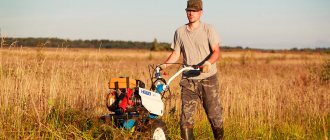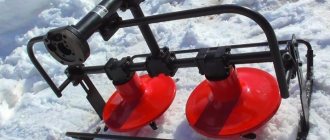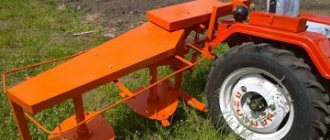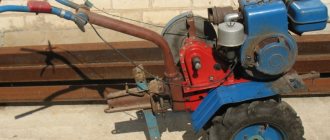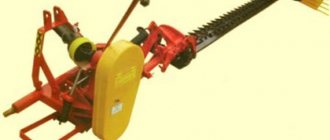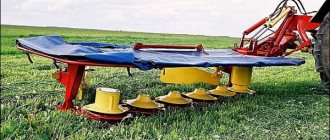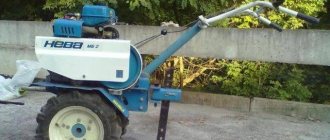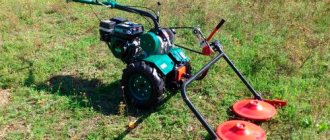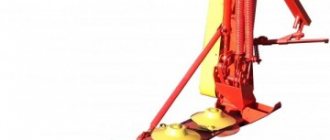Most people own not only city apartments, but also various country houses, which are a kind of transitional world between everyday bustle and quiet, rural life and tranquility. But such peace also has two sides, because the specifics of the countryside force us to take care of the local area in every possible way throughout the year.
This circumstance prompted the developers of agricultural machinery to design a compact and convenient device that would help people significantly simplify this entire process of improving their home. To put it simply, a walk-behind tractor was designed - an extremely useful unit that combines a variety of functionality and ease of operation.
There are many additional mounted structures on it that allow for snow removal, plowing of land, watering, hilling and, of course, mowing the grass surface . It is this equipment, i.e. mower for a walk-behind tractor, we will look at it in more detail.
Principle of operation
In this particular case, we take into account mowers designed for aggregation with the Neva walk-behind tractor, which is extremely popular among many farmers. This is due, first of all, to the fact that the model of this brand shows very decent performance characteristics for more than one year and in any weather conditions.
If we talk about the principle of operation of this device, then everything is quite simple - the mower mechanism starts immediately as soon as the chassis of the walk-behind tractor starts moving. Thus, traction is supplied to the mower and it begins its systematic work.
Technical aspect
The design of the mower includes a support wheel and several discs with cutting elements. As soon as this support wheel begins to move, the knives on the disks also come into action.
In general, the entire design of mowers for walk-behind tractors does not look very pretentious, which does not mean that working with them is insufficient. As a rule, depending on the configuration, the mower is equipped with one wheel, several metal bars connected to a support frame and a cutting system that mows the grass.
When choosing a unit, you should pay attention to several of its characteristics:
- height of the grass surface to be mowed;
- processed area, i.e. the number of hectares that the mower can mow within a certain period of time, for example, per day;
- rotation speed of the knives on the discs.
Features of work
In addition to these characteristic data, mowers are divided into rotary and segmented, which differ from each other not only in appearance and design, but also in technological characteristics.
Device
There are two modifications on the market: the Zarya mower and the Zarya-1 mower. The first option is divided into model KR.05.000 (designed for operation with walk-behind tractors produced by KADVI LLC) and KR.05.000-03 (variation intended for equipment from other manufacturers).
The attachments in question are aggregated with most domestic walk-behind tractors. The principle of operation of the mechanism is to cut grass using a pair of knives placed on disks. The elements are fixed loosely on cotter pins and, under the influence of centrifugal force during rotation, protrude beyond the edges of the disk, taking on a working position.
It is worth noting that for connecting the device to walk-behind tractors of different designs, there are several variations of mowers that differ in pulley drives and tensioner sizes. The main interaction is carried out through the knot with the belt. The Zarya-1 mower is designed for aggregation with the PTO output shaft of Ugra type equipment. Interaction is carried out through a standard or additional gearbox. The modification is lightweight, which makes it easier to connect to a walk-behind tractor. In addition, there is an option to adjust the height of the mowed grass.
Rotary mower
This type of mower design for the Neva walk-behind tractor consists of a support frame and several disks , usually two or three. This mower is mounted in front of the walk-behind tractor and cuts various grass surfaces, including thick and overgrown grass with weeds.
The rotary mower for the Neva walk-behind tractor has rightfully gained considerable popularity among farmers, because it copes with a large amount of work, and it calmly tolerates various uneven surfaces without compromising its performance.
It is very simple to operate; you do not need any special technical knowledge to work with it. This circumstance also affects the ease of repair of the released unit - in this configuration it is significantly simplified than in the segment one.
Rotary model
But dry descriptions are clearly not enough and it is necessary to consider specific examples on specific models of rotary mowers for the Neva walk-behind tractor.
One of the most popular and widespread options is the Zarya rotary mower for the Neva walk-behind tractor, but there are other models of this type, such as the Polish rotary mower. At the moment, the Zarya mower is produced in Russia and China. In our country, the company responsible for the release of this model has been engaged in the production and subsequent sale of agricultural machinery for a long time.
The quality of Chinese and Russian assembly is slightly different, but, in general, both options have the right to life. The only thing that needs to be noted is that the Chinese model must be disassembled and the gearbox thoroughly lubricated before operation. Judging by the reviews, there is not enough oil in it for the unit to operate correctly.
Features of the mower in the video.
Technical characteristics of the Zarya rotary mower:
- weight – 32 kg;
- overall speed – from 2 to 4 km/h;
- treated surface area – 0.2 ha/h;
- width of the mowed surface – 80 cm;
- disc rotation speed – from 2000 to 2400 rpm;
- the height of the grass surface to be cut is up to 1 meter.
The price for such a model will vary from 11 to 12 thousand rubles . However, if you decide to save money, we advise you to follow the link and get acquainted with the option of a homemade rotary mower for the Neva.
Rules of operation and adjustment
5.1. Recommendations for aggregation. Attaching the KS-F-2.1B mower to a tractor
5.1.1. Place the rear wheels of the tractor on a track of 1400-1500 mm. 5.1.2. Install the hydraulic lifting mechanism and hitch system on the tractor. 5.1.3. Using the tractor operating manual, limit the vertical movement of the trailing rods of the mounted system so that the holes in the spherical hinges of their rear ends cannot rise above 700 mm and fall below 400 mm from the supporting plane. 5.1.4. Reverse the tractor towards the mower and lower the hydraulic linkage so that the hinges on the rear ends of the trailing rods are positioned against the axis of the frame linkage. The axis of the hitch must be parallel to the ground. 5.1.5. Place the hydraulic mechanism distributor handle in the “floating” position. 5.1.6. Get off the tractor, connect first one and then the other longitudinal rods of the factor linkage to the mower linkage axle and secure them with tractor pins. 5.1.7. Connect the central link of the tractor attachment to the mower using a pin at the upper end of the frame. 5.1.8. Install the front driveline joint of the mower onto the PTO and secure it. Secure the chain. 5.1.9. Install the rear universal joint on the flywheel and secure it. Attach the chain to the pendant. 5 1.10. Install the drive belt guard. 5.1.11. Block the longitudinal links of the mounted system with special devices supplied with the tractor, so that the mower frame does not have a lateral displacement relative to the longitudinal axis of the tractor. 5.1.12. Adjust the length of the tractor's central link so that the support arm of the hitch axle is positioned vertically to the ground. 5.1.13. Connect the high pressure hose through the adapter fitting to the hydraulic cylinder and, through the breakaway coupling, to the hydraulic system of the tractor.
5.2. Regulation.
5.2.1. Adjust the position of the knife in the cutterbar so that when the cutterbar is assembled, the front ends of the segments rest on the guard plates of the fingers. Fingers with a gap between the end of the segment and the shear plate or having a vertical deviation compared to others, straighten them with careful blows of a hammer on the tip of the finger. A gap of up to 1 mm is allowed between the segments and the rear ends of the shear blades. The knife clamps must touch the segments; If there is a gap, bend them with light blows of a hammer. For normal operation of the cutting apparatus, it is necessary that the knife segments be sharply sharpened and located in the same plane. If any segment deviates, carefully straighten it. After straightening the pins and clamps, tighten all bolts securing the pins with nuts until full. 5.2.2. Adjust the position of the cutting device relative to the tractor so that in the cutting device the tip of the finger located next to the outer shoe extends forward (along the tractor) by 35-55 mm relative to the tip of the finger located next to the inner shoe. This is achieved by changing the length of the truss. 5.2.3. Adjust the position of the connecting rod so that in the extreme positions of the connecting rod the middle of the knife segments reaches the middle of the fingers. This is achieved by changing the length of the connecting rod by rotating the head housing. Overrunning of the knife towards the outer shoe is not allowed, since in this case, when installing the cutting device in the transport (vertical) position, the connecting rod will be pushed into position. For smoother operation of the knife and connecting rod in the working position, the center line of the connecting rod should preferably lie parallel to the center line of the knife (when viewed from above).
Adjust the relative position of the connecting rod and the knife by turning the eccentric bushing (4) (Fig. 3) in the shoe hinge (3). To do this, unscrew the bolt, turn the bushing (4) in the required direction and install the bolt in another hole in the bushing. 5.2.4. Adjust the tilt of the cutterbar. Having loosened the bolt connecting the hinge (3) (Fig. 3) to the drawbar beam (7), adjust the installation of the hinge and the cutting device connected to it at the required angle of inclination forward or backward within the elongated hole of the bracket welded to the beam. When the grass is laid down, tilt the cutting device forward so that the fingers do not press the grass, but go deeper into the laid down mass, lifting it. When working on uneven or rocky soil, tilt the cutting unit backwards to prevent the tines from digging into the ground and skipping stones underneath. 5.2.5. Adjust the cutting height by rearranging the soles of the inner and outer shoes: for an increased cutting height - to the holes located above, for a lower height - to the holes located below. 5.2.6. Adjust the field board and inner shoe guard to securely separate clipped grass from uncut grass and clear the path for the inner shoe to pass on the next run. 5.2.7. Adjust the pressure of the shoes on the soil so that when the cutting device and tractor wheels are located on a horizontal supporting surface, the pressure of the inner shoe is 200-300N (20-30 kg), the pressure of the outer shoe is 100-200N (10-20 kg). Adjust the pressure of the inner and outer shoes on the soil by changing the tension of the spring of the balancing mechanism. 5.2.8. Adjust the tension of the V-belts by moving the drive pulley using a tension screw with a spring.
5.3. Job.
5.3.1. Operate the tractor engine at full speed. 5.3.2. Adjust the operating speed depending on the terrain and micro-topography of the area. Reduce speed if areas are uneven. Use powerful tractors in higher gears with reduced engine speeds by adjusting the throttle. 5.3.3. The mower's cutting device must operate across the entire working width. To do this, drive the tractor so that the inner shoe goes as close as possible to the edge of the uncut grass. 5.3.4. If grass hangs over the cutting device, do not turn off the mower drive, move the tractor back a little, then raise and lower the cutting device using the tractor’s hydraulic mechanism to remove the hanging mass from it. 5.3.5. When moving a tractor with a mower over short distances (turns in the mowing area, minor moving from area to area), lift the cutting device using the hydraulic mechanism of the tractor. 5.3.6. To move long distances, install the cutting device in the vertical (transport) position. To do this, turn the eccentric so that the connecting rod takes the left extreme position, then lift the cutting device using the hydraulic mechanism of the tractor, manually turn it up to a vertical position, pass the end of the transport rod into the hole of the pin bar and screw the nuts onto it. 5.3.7. Use the tractor hitch to raise the mower to the required height for moving.
5.4. Transportation.
5.4.1. Mowers are sent from the factory in semi-assembled form with components and kits removed according to the “Completing List”. 5.4.2. The bag contains small parts, spare parts and technical documentation, packed in a plastic film bag. 5.4.3. The mower is transported by road and rail. 5.4.4. The method of loading, as well as the placement and fastening of packaging during transportation must ensure complete safety of assembly units and parts from mechanical damage and preservation of presentation.
This is interesting: Bobcat S300 mini loader. Characteristics, prices and analogues
Segment model
This type of mower is a more complex design than a rotary mower. It is used on various sites, both with a flat surface and with more complex terrain. Thanks to the design of the cutting elements, the segment mower mows the grass very evenly and thoroughly, regardless of the density and germination of the grass surface. Read about another mower model for tall grass and uneven areas here.
The design of the segment mower for the Neva walk-behind tractor consists of a main frame attached to the front of the walk-behind tractor, a wheel that receives rotational movements from the walk-behind tractor chassis, and cutting elements that include two metal bars, between which there are knives. At the edges of the cutting system there are special slides with which you can adjust the height of the cut grass.
Segment lawn mower
The process of working with such a mower is quite simple, and most importantly, safe. This is achieved by the fact that the design includes a special protective casing that prevents various damages.
Let's take a closer look at the example of a specific model. Let's take the segment mower for the Neva KN 1.1 walk-behind tractor, which is an excellent option for people who have a lot of livestock that need to constantly make hay.
The segment mower for the Neva KN 1.1 walk-behind tractor is designed for MB 1 and MB 2 walk-behind tractors , which are varieties of the Neva walk-behind tractor. Thanks to its design, the mower for the Neva MB 2 walk-behind tractor allows you to cut grass and place it in special windrows, i.e. in even rows so that it can be easily collected later.
This model, which can work even in the most problematic areas with thick and overgrown grass, is produced at several domestic factories.
Technical characteristics of Neva KN 1.1:
- weight – 45 kg;
- grass cutting height – from 40 mm;
- width of the mowed surface – 110 cm;
- treated surface area – 0.35 ha/h;
- general speed – 5 km/h.
For those who decide to purchase it in specialized stores, you need to know its price, which will be at least 11 thousand rubles, and in some places even higher. Therefore, many people wonder: is it possible to make a similar mower for a walk-behind tractor with your own hands?
Walk-behind mower
And indeed, this problem arises more and more often, because not everyone has enough money to purchase this or that unit. Below we will look at a way out of such situations.
Features of application
Farmers fell in love with the rotary mower because of its simplicity of design, it is easy to set up before work, and you can replace any part with your own hands. A rotary mower is a frame to which working parts in the form of disks are attached. Each disk contains several knives, which, when working under the influence of centrifugal force, unfold like petals and cut the grass.
A rotary mower is used for cleaning grass in the courtyard area, in areas of no more than 2 hectares and along highways. Availability of spare parts depends on the model and manufacturer. You can buy an imported model from Western or Chinese manufacturers and a domestic one. Spare parts for domestic mowers can be purchased without difficulty, but for imported ones it is more difficult. But Western models have high quality, so the design will begin to break down 5-7 years after purchase. Chinese technology is not of high quality, but even here you can get lucky.
How to choose the right model for your farm?
Rotary mower for harvesting grass on a personal plot
Before you buy a rotary mower, you need to understand the types and their purpose.
According to the method of cutting grass, they are divided into:
- For chopping, mulch vegetation.
- For cutting and laying in even rows or mowing. Suitable for making hay for livestock.
According to the method of aggregation with mini tractors:
- Trailed. Attached at the back. Most models mulch grass.
- Semi-mounted. Attached to the side.
- Mounted. Attached to the front of the equipment.
They also differ in the way the mower is connected - from the running wheels or drive.
Models differ in functionality, mobility, performance and durability. If you want to buy an inexpensive mower with high quality, we recommend taking ours or a Belarusian one. The equipment was assembled to suit our conditions and performed well when working on uneven and clogged areas.
Let's take a closer look at the most popular models for mini tractors Uralets and Scout, which have received positive reviews from users.
Homemade design
The first thing any person who decides to design homemade equipment should know is that it must, first of all, be safe for him and others. In such cases, the quality of the unit’s operation fades into the background when the question of a real threat to human life and health arises, because the mower has many cutting and sharp elements, from which it is very easy to get hurt.
Having understood this rule, you can begin the process of assembling the mower. However, you first need to choose the material from which it will be made. See the photo for an example of a homemade mower.
Homemade device
The main point here is that a person who is passionate about the idea of constructing a homemade mower wants to significantly save his already modest finances. Therefore, the material should be used from old and used agricultural equipment, which can be found at home or in abandoned warehouses and farms. There are many different options for how to make a lawn mower with your own hands from available materials, which you can learn about from this article.
Let's consider the process of assembling a segment mower for the Neva walk-behind tractor with your own hands. Having decided on the material, you can begin the assembly itself.
Metal bars are taken, the dimensions of which will be 15x50x120. In each of them, you need to drill twelve holes equidistant from each other of such a diameter that M8 bolts fit under them. Next, we make a rail with cutting elements 89 cm long, which we screw onto these bolts.
Assembly drawing
Along the edges of these beams, we install clamps and slides, with which you can adjust the height of the grass cut. The design of the segment mower includes a wheel , which can be taken, for example, from an old baby stroller. It is this wheel that will receive the driving force from the walk-behind tractor when it is put into action.
The rating of the most powerful truck cranes will help you not to make a mistake in choosing a reliable and strong assistant.
We invite you to read the article, which describes in detail the permitted maximum weight for the KamAZ 4308, because the service life of the tractor depends on this.
The answer to the question: “How to choose a saw for cutting firewood?”, you can easily find here //machinspec.com/lesozagotovitelnaya/benzopila/kak-vybrat.html.
In general, this description is quite schematic; only the main points regarding the manufacture of a homemade segment mower are described here. But for a person who is well acquainted with the principles of such work, it will not be at all difficult to apply this data in practice, and perhaps add something of his own from his personal experience.
A do-it-yourself mower for the Neva walk-behind tractor, the drawings of which can be easily found in publicly available sources, is an excellent way out of a situation where there is not enough extra money to purchase additional and, importantly, expensive components. But if you are not eager to tinker with drawings, then you can safely familiarize yourself with an alternative in the form of inexpensive electric lawn mowers.
DIY mower
How to make a haymower with your own hands?
The process of creating a rotary mower is not that complicated, the main thing is to have patience, tools and spare parts. It is also very encouraging that old scrap metal can be used to construct a mower. Minimal knowledge and ability to work with a welding machine will allow you to create a productive agricultural assistant with your own hands.
Step-by-step instruction
- The frame of a homemade device should be welded from metal pieces of a corner;
- You need to take discs from an unnecessary seeder;
- Place 4 blades on them, then drill the same number of holes in them (0.6 cm in diameter).
- Attach them to the disks so that the distance between the mount and the blade is 1 mm wider than the thickness of the blade itself.
